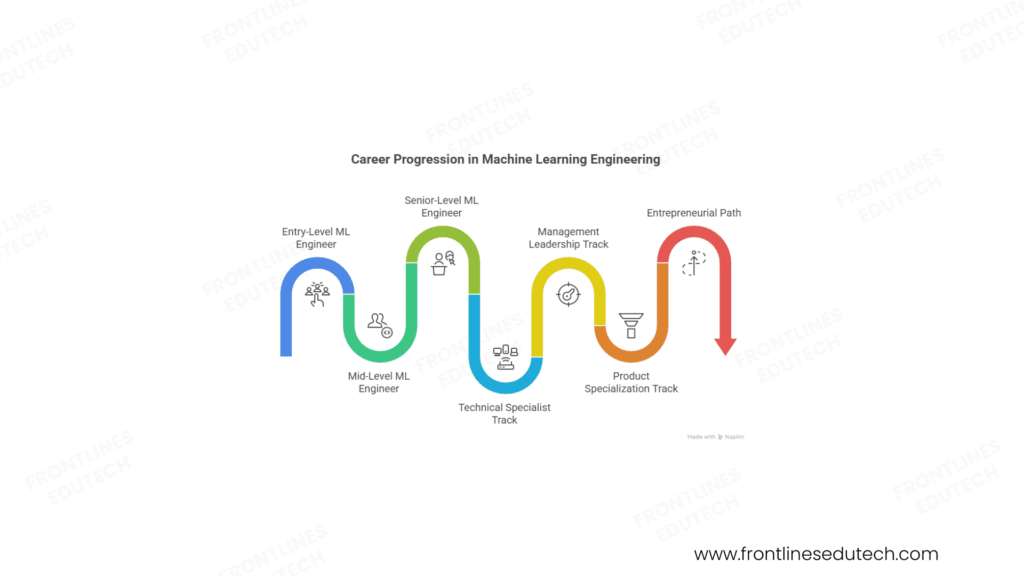How to Become a Machine Learning Engineer: Complete Career Guide [₹10.8L Average Salary]
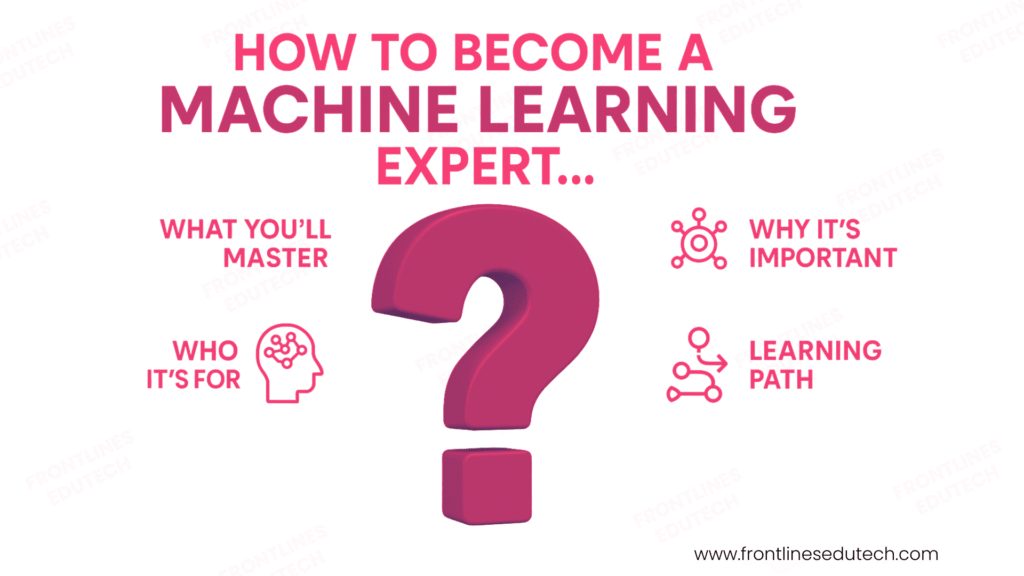
Build the future with AI and transform your career with India’s fastest-growing tech skill
Machine Learning Engineers in India are commanding impressive salaries, with average annual earnings reaching ₹10.88 lakhs, and experienced professionals earning upwards of ₹20 lakhs per year. As artificial intelligence reshapes every industry from healthcare to finance, machine learning has emerged as one of the most sought-after and future-proof career paths in technology.
Whether you’re a fresh graduate eager to enter the world of AI, a software developer looking to upskill, or a professional planning a career transition, this comprehensive guide will walk you through the exact steps to become a Machine Learning Engineer in 2025. Drawing from proven methodologies that have helped hundreds of students successfully transition into ML roles at Frontlines EduTech, this roadmap eliminates confusion and provides you with a clear, actionable path forward.
What you’ll discover in this guide:
- Core machine learning technologies and mathematical foundations
- Month-by-month learning roadmap with realistic timelines
- Hands-on projects that build your professional portfolio
- Industry-recognized tools and frameworks (Python, TensorFlow, PyTorch)
- Job search strategies tailored for ML positions
- Salary expectations across different experience levels
- Success strategies from career changers who made it
⚡ Become a Job-Ready Machine Learning Engineer
Master Python, ML, Deep Learning, MLOps & Deployment with our Machine Learning Course
1.What is Machine Learning Engineering?
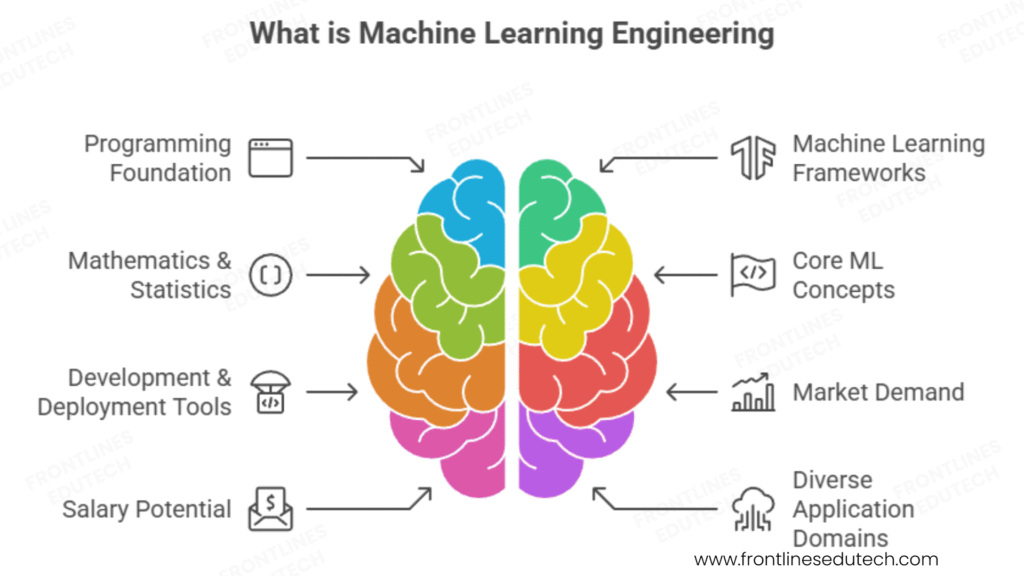
Machine learning engineering combines data science, software engineering, and artificial intelligence to build systems that learn from data and make intelligent decisions without explicit programming. A Machine Learning Engineer designs, develops, and deploys ML models that power everything from Netflix’s recommendation system to self-driving cars and voice assistants like Alexa.
Unlike traditional programming where you write specific instructions for every scenario, machine learning enables computers to learn patterns from data and improve their performance over time.
Core Technologies in Machine Learning:
Programming Foundation:
- Python – The dominant language for ML with extensive library support
- NumPy & Pandas – Data manipulation and numerical computing
- SQL – Database querying and data extraction
- Git/GitHub – Version control and collaborative development
Machine Learning Frameworks:
- TensorFlow – Google’s open-source framework for production-scale ML
- PyTorch – Facebook’s research-focused framework with dynamic computation
- Scikit-learn – Classical machine learning algorithms and tools
- Keras – High-level neural networks API for rapid prototyping
Mathematics & Statistics:
- Linear Algebra – Vectors, matrices, eigenvalues for model operations
- Calculus – Derivatives and optimization for training algorithms
- Probability & Statistics – Distributions, hypothesis testing, Bayesian methods
- Optimization Techniques – Gradient descent and advanced optimizers
Core ML Concepts:
- Supervised Learning – Classification and regression with labeled data
- Unsupervised Learning – Clustering and dimensionality reduction
- Deep Learning – Neural networks for complex pattern recognition
- Natural Language Processing – Text analysis and language understanding
- Computer Vision – Image recognition and object detection
Development & Deployment Tools:
- Jupyter Notebooks – Interactive development and experimentation
- Docker – Containerization for model deployment
- Cloud Platforms – AWS, Google Cloud, Azure for scaling models
MLOps Tools – Model versioning, monitoring, and automation
2.Why Choose Machine Learning Engineering ?
Explosive Market Demand
Programming Foundation:
- Python – The dominant language for ML with extensive library support
- NumPy & Pandas – Data manipulation and numerical computing
- SQL – Database querying and data extraction
- Git/GitHub – Version control and collaborative development
Machine Learning Frameworks:
- TensorFlow – Google’s open-source framework for production-scale ML
- PyTorch – Facebook’s research-focused framework with dynamic computation
- Scikit-learn – Classical machine learning algorithms and tools
- Keras – High-level neural networks API for rapid prototyping
Mathematics & Statistics:
- Linear Algebra – Vectors, matrices, eigenvalues for model operations
- Calculus – Derivatives and optimization for training algorithms
- Probability & Statistics – Distributions, hypothesis testing, Bayesian methods
- Optimization Techniques – Gradient descent and advanced optimizers
Core ML Concepts:
- Supervised Learning – Classification and regression with labeled data
- Unsupervised Learning – Clustering and dimensionality reduction
- Deep Learning – Neural networks for complex pattern recognition
- Natural Language Processing – Text analysis and language understanding
- Computer Vision – Image recognition and object detection
Development & Deployment Tools:
- Jupyter Notebooks – Interactive development and experimentation
- Docker – Containerization for model deployment
- Cloud Platforms – AWS, Google Cloud, Azure for scaling models
- MLOps Tools – Model versioning, monitoring, and automation
Why Choose Machine Learning Engineering in 2025?
Explosive Market Demand
The demand for AI and machine learning specialists is projected to increase by 40% – representing 1 million new jobs – over the next five years according to the World Economic Forum. Machine Learning Engineer ranks #8 among the best jobs in the U.S., with a 53% growth rate since 2020.
Indian companies across sectors are actively hiring ML engineers:
- Technology Giants – Google India, Microsoft, Amazon, Adobe
- Banking & Fintech – HDFC Bank, Paytm, PhonePe, Razorpay
- E-commerce – Flipkart, Amazon India, Swiggy, Zomato
- Healthcare Tech – Practo, 1mg, HealthifyMe
- Automotive – Ola, Uber, automotive manufacturers developing autonomous systems
Outstanding Salary Potential
Machine learning engineering offers exceptional compensation with clear growth trajectories:

Source: Multiple industry salary reports 2025
Diverse Application Domains
Machine Learning Engineers can work across fascinating industries:
- Healthcare – Disease diagnosis, drug discovery, personalized medicine
- Finance – Fraud detection, algorithmic trading, credit risk assessment
- Retail & E-commerce – Recommendation systems, inventory optimization
- Autonomous Vehicles – Self-driving cars, driver assistance systems
- Entertainment – Content recommendation, personalized user experiences
- Cybersecurity – Threat detection, anomaly identification
- Education Technology – Personalized learning paths, intelligent tutoring systems
3.Complete Learning Roadmap (8-10 Months)
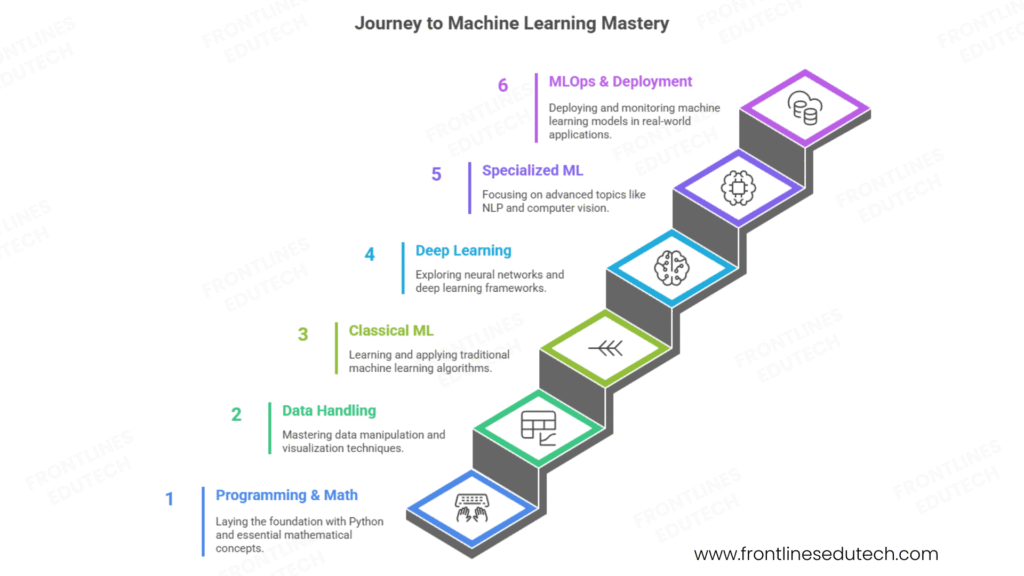
Phase 1: Programming & Mathematics Foundation (Months 1-3)
Python Programming Mastery (4-6 weeks)
- Variables, Data Types & Control Structures – Foundation building blocks
- Object-Oriented Programming – Classes, inheritance, polymorphism
- File I/O Operations – Reading and writing data files
- Exception Handling – Robust error management
- List Comprehensions & Generators – Efficient data processing
- Lambda Functions & Decorators – Advanced Python techniques
Hands-on Python Projects:
- Temperature Converter with GUI – Building user interfaces
- Web Scraper for Data Collection – Extracting real-world data
- Personal Budget Tracker – Working with file storage and calculations
Mathematics for Machine Learning (6-8 weeks)
- Linear Algebra Essentials – Vectors, matrices, matrix operations, eigenvalues
- Calculus Fundamentals – Derivatives, partial derivatives, chain rule, gradient
- Probability Theory – Distributions, Bayes’ theorem, conditional probability
- Statistics Foundations – Mean, variance, hypothesis testing, p-values
- Optimization Concepts – Gradient descent, convex optimization
Data Handling with NumPy & Pandas (3-4 weeks)
- NumPy Arrays – Multi-dimensional array operations and vectorization
- Pandas DataFrames – Data loading, cleaning, and transformation
- Data Aggregation – GroupBy operations and pivot tables
- Handling Missing Data – Imputation techniques and strategies
- Data Visualization – Matplotlib and Seaborn for exploratory analysis
Practical Data Projects:
- Exploratory Data Analysis on Titanic Dataset – Statistical insights
- COVID-19 Data Visualization Dashboard – Time series analysis
- IPL Cricket Statistics Analysis – Sports analytics practice
Phase 2: Classical Machine Learning (Months 4-5)
Supervised Learning Algorithms (5-6 weeks)
- Linear Regression – Predicting continuous values with mathematical modeling
- Logistic Regression – Binary and multi-class classification
- Decision Trees – Rule-based classification and regression
- Random Forests – Ensemble learning for improved accuracy
- Support Vector Machines – Maximum margin classification
- K-Nearest Neighbors – Instance-based learning approach
- Naive Bayes – Probabilistic classification
Unsupervised Learning Techniques (3-4 weeks)
- K-Means Clustering – Partitioning data into groups
- Hierarchical Clustering – Tree-based grouping methods
- DBSCAN – Density-based spatial clustering
- Principal Component Analysis (PCA) – Dimensionality reduction
- Association Rule Learning – Market basket analysis
Model Evaluation & Optimization:
- Train-Test Split Methodology – Preventing overfitting
- Cross-Validation Techniques – K-fold and stratified validation
- Performance Metrics – Accuracy, precision, recall, F1-score, ROC-AUC
- Hyperparameter Tuning – Grid search and random search
- Bias-Variance Tradeoff – Balancing model complexity
Portfolio Projects for This Phase:
- House Price Prediction System – Regression with multiple features
- Credit Card Fraud Detection – Classification with imbalanced data
- Customer Segmentation Analysis – Clustering for marketing insights
- Spam Email Classifier – Text classification fundamentals
Phase 3: Deep Learning & Neural Networks (Months 6-7)
Neural Networks Fundamentals (4-5 weeks)
- Perceptrons & Multi-Layer Networks – Building blocks of neural networks
- Activation Functions – ReLU, Sigmoid, Tanh, Softmax
- Forward & Backward Propagation – How networks learn
- Loss Functions – MSE, Cross-entropy, custom losses
- Optimization Algorithms – SGD, Adam, RMSprop
- Regularization Techniques – Dropout, L1/L2 regularization, batch normalization
TensorFlow & PyTorch Mastery (3-4 weeks)
- TensorFlow Basics – Tensors, computational graphs, sessions
- PyTorch Fundamentals – Dynamic graphs, autograd, tensor operations
- Building Neural Networks – Sequential and functional APIs
- Model Training – Custom training loops and callbacks
- Model Evaluation – Validation strategies and metrics
- Framework Comparison – When to use TensorFlow vs PyTorch
Convolutional Neural Networks (CNNs):
- Convolution & Pooling Operations – Feature extraction from images
- CNN Architectures – LeNet, AlexNet, VGG, ResNet
- Transfer Learning – Using pre-trained models
- Image Classification – Multi-class image recognition
- Object Detection – YOLO, R-CNN families
Recurrent Neural Networks (RNNs):
- Sequential Data Processing – Time series and text sequences
- LSTM & GRU Networks – Handling long-term dependencies
- Sequence-to-Sequence Models – Translation and generation
- Attention Mechanisms – Focus on relevant information
Deep Learning Projects:
- Image Classification with CNN – Dogs vs Cats recognition
- Sentiment Analysis System – Analyzing movie reviews or product feedback
- Stock Price Prediction – Time series forecasting with LSTM
- Handwritten Digit Recognition – MNIST classification challenge
Phase 4: Specialized ML & Real-World Applications (Months 8-10)
Natural Language Processing (NLP) (3-4 weeks)
- Text Preprocessing – Tokenization, stemming, lemmatization
- Word Embeddings – Word2Vec, GloVe, FastText
- Transformer Architecture – BERT, GPT foundations
- Text Classification – Sentiment analysis, topic modeling
- Named Entity Recognition – Extracting information from text
- Language Translation – Sequence-to-sequence models
Computer Vision Advanced Topics (2-3 weeks)
- Object Detection – Real-time detection systems
- Image Segmentation – Pixel-level classification
- Facial Recognition – Detection and verification
- Generative Models – GANs for image generation
MLOps & Model Deployment (4-5 weeks)
- Model Serialization – Saving and loading models (pickle, joblib, ONNX)
- Flask/FastAPI – Creating ML APIs for production
- Docker Containerization – Packaging models for deployment
- Cloud Deployment – AWS SageMaker, Google Cloud AI, Azure ML
- Model Monitoring – Performance tracking in production
- CI/CD for ML – Automated testing and deployment pipelines
Capstone Project Options:
- End-to-End Recommendation System – Like Netflix or Amazon suggestions
- Real-Time Face Mask Detection System – Computer vision application
- Chatbot with Natural Language Understanding – NLP implementation
- Automated Resume Screening System – Classification with business impact
- Healthcare Disease Prediction Platform – Medical ML application
🗺️ Follow the Complete Machine Learning Roadmap
Beginner → Classical ML → Deep Learning → MLOps → Deployment Open Roadmap →
4. Essential Tools and Development Environment
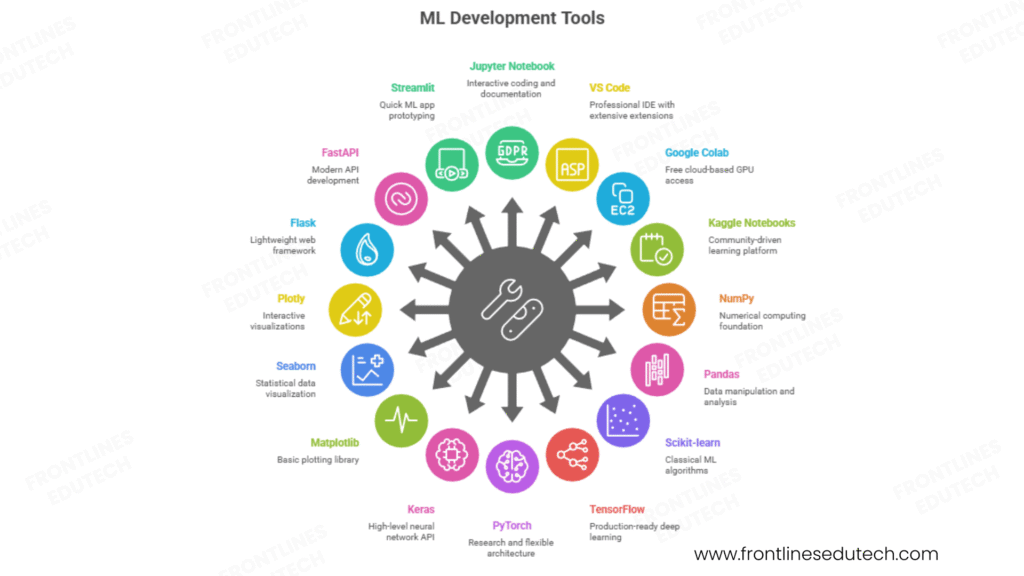
Integrated Development Environment
Jupyter Notebook/JupyterLab (Recommended for beginners)
- Interactive Development – See results immediately as you code
- Markdown Support – Document your analysis alongside code
- Visualization Integration – Plots display directly in notebooks
- Data Exploration – Perfect for experimenting with datasets
- Free and Open Source – No licensing costs
VS Code with Python Extensions
- Professional IDE – Industry-standard development environment
- Debugging Support – Advanced debugging capabilities
- Git Integration – Built-in version control
- Extensions Ecosystem – Jupyter, Python, and ML-specific tools
- Remote Development – Work on cloud instances seamlessly
Cloud Platforms for ML
Google Colab (Best for beginners)
- Free GPU Access – Train models without expensive hardware
- Pre-installed Libraries – TensorFlow, PyTorch ready to use
- Collaborative – Share notebooks easily
- Cloud Storage Integration – Connect with Google Drive
Kaggle Notebooks
- Free Computing Resources – GPU and TPU access
- Dataset Integration – Thousands of datasets instantly available
- Community Learning – Learn from others’ notebooks
- Competition Platform – Practice with real challenges
Essential Python Libraries
Data Processing:
- NumPy – Numerical computing foundation
- Pandas – Data manipulation and analysis
- Scikit-learn – Classical ML algorithms
Deep Learning:
- TensorFlow – Production-ready deep learning
- PyTorch – Research and flexible architecture
- Keras – High-level neural network API
Visualization:
- Matplotlib – Basic plotting library
- Seaborn – Statistical data visualization
- Plotly – Interactive visualizations
Model Deployment:
- Flask – Lightweight web framework
- FastAPI – Modern API development
- Streamlit – Quick ML app prototyping
5.Building Your ML Portfolio
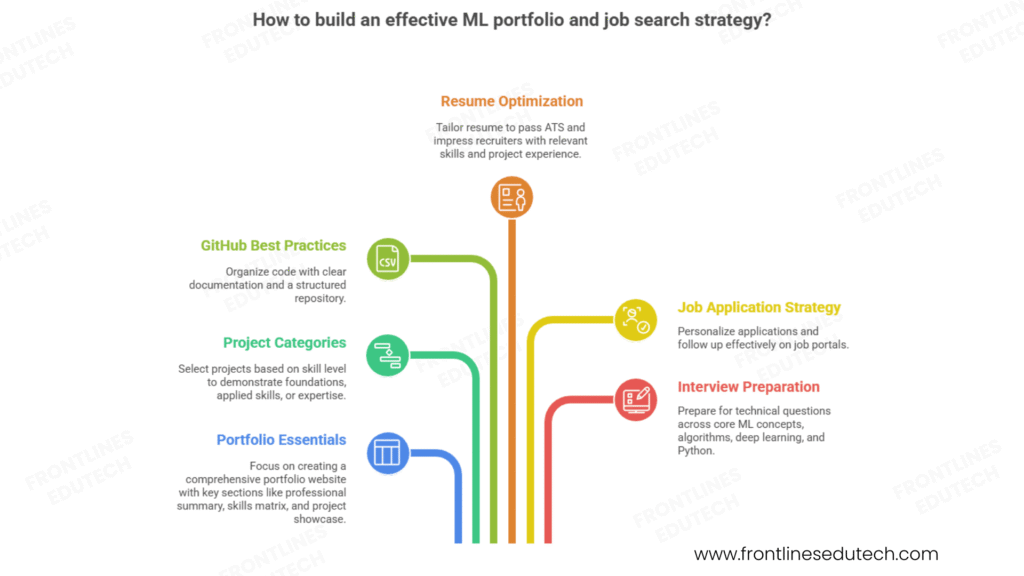
Portfolio Website Essentials
Your machine learning portfolio should demonstrate both technical depth and practical problem-solving abilities:
Critical Sections:
- Professional Summary – Your ML journey and specialization areas
- Technical Skills Matrix – Programming, frameworks, ML techniques
- Project Showcase – 5-7 well-documented ML projects with demos
- GitHub Repository – Clean, documented code with README files
- Kaggle Profile – Competition participation and rankings
- Publications/Blogs – Technical writing demonstrates expertise
- Certifications – Relevant ML courses and credentials
Project Categories for Your Portfolio
Beginner Projects (Demonstrate Foundations):
- Iris Flower Classification – Multi-class classification basics
- Boston Housing Price Prediction – Regression fundamentals
- Loan Approval Prediction – Binary classification with real data
- Customer Churn Prediction – Business-focused classification
Intermediate Projects (Show Applied Skills):
- Movie Recommendation System – Collaborative filtering implementation
- Credit Card Fraud Detection – Handling imbalanced datasets
- Sentiment Analysis on Twitter Data – NLP and social media analytics
- Sales Forecasting System – Time series prediction
Advanced Projects (Demonstrate Expertise):
- Real-Time Object Detection App – Computer vision with deployment
- Question Answering System – Advanced NLP with transformers
- Stock Market Prediction Platform – Multi-feature time series
- Deepfake Detection System – Cutting-edge computer vision
GitHub Best Practices for ML Projects
Repository Structure:
project-name/
├── README.md (Comprehensive project overview)
├── requirements.txt (All dependencies with versions)
├── data/ (Sample data or data loading scripts)
├── notebooks/ (Jupyter notebooks for exploration)
├── src/ (Source code modules)
│ ├── data_preprocessing.py
│ ├── model.py
│ ├── train.py
│ └── predict.py
├── models/ (Saved model files)
├── tests/ (Unit tests for your code)
└── deployment/ (API code, Docker files)
Documentation Standards:
- Clear Problem Statement – What business problem does this solve?
- Dataset Description – Source, size, features explained
- Methodology – Model selection rationale and approach
- Results & Metrics – Performance metrics with visualizations
- Installation Guide – Step-by-step setup instructions
- Demo/Screenshots – Visual proof of working project
- Future Improvements – Shows forward thinking
Deep Learning Questions:
- What’s the difference between CNN, RNN, and Transformer architectures?
- Explain how batch normalization helps neural network training
- When would you use LSTM over simple RNN?
- What is transfer learning and when is it beneficial?
- How does attention mechanism work in transformers?
- Explain dropout regularization and its effect on training
- What are the differences between TensorFlow and PyTorch?
- How do you prevent overfitting in deep neural networks?
Python and Data Science Questions:
- Implement a function to split data into train-test sets without using sklearn
- How do you handle missing data in a dataset? Discuss multiple approaches
- Write code to perform feature scaling using standardization
- Explain the difference between NumPy arrays and Python lists
- How would you detect and handle outliers in a dataset?
- Demonstrate how to use pandas groupby for data aggregation
- What’s the difference between shallow and deep copy in Python?
- Implement a simple linear regression from scratch using NumPy
System Design and MLOps Questions (Senior Roles):
- Design a recommendation system for an e-commerce platform handling millions of users
- How would you deploy a machine learning model to production?
- Explain A/B testing for ML models and how you’d implement it
- Design a real-time fraud detection system for banking transactions
- How do you monitor ML model performance in production?
- Explain model versioning and why it’s important
- Design a scalable architecture for training models on large datasets
- How would you handle model drift and retraining strategies?
Behavioral Interview Questions:
- Describe a machine learning project where you faced significant challenges
- How do you explain complex ML concepts to non-technical stakeholders?
- Tell me about a time when your model didn’t perform as expected
- How do you stay updated with the latest developments in ML?
- Describe a situation where you had to work with incomplete or messy data
- How do you prioritize when working on multiple ML projects?
- Tell me about a time you collaborated with cross-functional teams
- Describe your approach to debugging a poorly performing model
Coding Challenge Preparation
Practice Platforms:
LeetCode – 150+ ML-related algorithm problems, focus on medium difficulty
HackerRank – ML-specific tracks with hands-on coding challenges
Kaggle – Real datasets and competitions for practical experience
CodeSignal – Timed coding assessments used by companies
Recommended Daily Routine:
- 30 minutes – Solve 1-2 algorithm problems (arrays, strings, trees)
- 30 minutes – Implement ML algorithm from scratch (linear regression, K-means)
- 20 minutes – Review ML theory concepts and common interview questions
- 10 minutes – Practice explaining technical concepts clearly
Mock Interview Practice
Resources for Practice:
- Pramp – Free peer-to-peer mock interviews with ML engineers
- Interviewing.io – Anonymous technical interviews with engineers from top companies
- Study Groups – Form groups with fellow learners for weekly practice
- Mentor Sessions – Schedule mock interviews with experienced ML professionals
🧠 Crack ML Interviews Faster
Get 250+ real ML, Deep Learning & MLOps interview questions with solutions Open Interview Guide →
6. Job Search Strategy for ML Roles
Resume Optimization for Machine Learning Positions
Your machine learning resume must pass both Applicant Tracking Systems (ATS) and impress human recruiters.
Technical Skills Section Organization:
Programming Languages: Python (Advanced), R, SQL, Java, C++
Machine Learning Frameworks: TensorFlow, PyTorch, Scikit-learn, Keras, XGBoost, LightGBM
Data Processing Libraries: NumPy, Pandas, SciPy, PySpark for big data
Visualization Tools: Matplotlib, Seaborn, Plotly, Tableau for data storytelling
Development Tools: Jupyter Notebook, Git/GitHub, Docker, Kubernetes
Cloud Platforms: AWS (SageMaker, EC2), Google Cloud Platform (Vertex AI), Microsoft Azure ML
Databases: MySQL, PostgreSQL, MongoDB, Redis
MLOps Tools: MLflow, Kubeflow, Airflow, DVC (Data Version Control)
Project Experience Format – The STAR Method
Structure each project to demonstrate business impact, not just technical skills.
Example Format:
Customer Churn Prediction System [GitHub Link] [Live Demo]
Situation: Developed ML solution to identify customers at risk of leaving subscription service
Task: Built classification model to predict churn probability with 85% accuracy requirement
Action: Engineered 23 features from transaction data, tested 5 algorithms (Random Forest, XGBoost, Neural Networks), implemented SMOTE for class imbalance, deployed model as REST API using Flask and Docker
Result: Achieved 89% accuracy and 0.92 AUC score, identified 3,200 at-risk customers monthly, enabled targeted retention campaigns reducing churn by 18%
Metrics to Highlight:
- Model Performance – Accuracy, precision, recall, F1-score, AUC-ROC
- Business Impact – Cost savings, revenue increase, efficiency improvements
- Scale – Dataset size, processing speed, number of predictions
- Technologies – Specific frameworks and deployment
- tools used
Job Portals and Application Strategy
Primary Job Platforms for ML Roles:
Naukri.com – 1,500+ monthly ML job postings in India, strong enterprise presence
LinkedIn Jobs – Direct recruiter access, networking opportunities with hiring managers
Indeed India – Comprehensive salary insights and company reviews from employees
AngelList – Startup ecosystem with equity compensation and early-stage opportunities
Specialized ML/Data Science Platforms:
Kaggle Jobs – ML-focused positions valuing competition performance and notebooks
AI Jobs Board – Curated AI/ML opportunities from global companies
Machine Learning Jobs – Specialized portal for ML engineers and data scientists
Toptal – Freelance and contract ML positions for experienced professionals
Turing.com – Remote ML engineering jobs with US-based companies
Application Best Practices
Personalization Strategy:
- Research Company’s ML Applications – Understand their AI products and challenges
- Customize Cover Letter – Mention specific company projects and how you can contribute
- Align Projects with Role – Highlight portfolio projects matching job requirements
- Use Company’s Technical Stack – Emphasize experience with their preferred tools
Follow-up Protocol:
- Wait 5-7 business days before first follow-up email
- Send professional LinkedIn connection request to recruiter
- Provide additional portfolio links or case studies if applicable
- Maintain tracking spreadsheet with application dates and statuses
Networking Approach:
- Connect with ML engineers at target companies on LinkedIn
- Attend ML meetups and conferences (PyData, TensorFlow User Groups)
- Participate in Kaggle competitions to build credibility
- Contribute to ML open-source projects for visibility
Interview Preparation Framework
Technical Interview Categories
Core Machine Learning Concepts Questions:
- Explain the bias-variance tradeoff with a real-world example
- What is the difference between supervised, unsupervised, and reinforcement learning?
- How do you handle overfitting in machine learning models?
- Explain cross-validation and why it’s important
- What’s the difference between L1 and L2 regularization?
- How would you evaluate a classification model with imbalanced classes?
- Explain the working of gradient descent and its variants
- What is the curse of dimensionality and how do you address it?
Algorithm-Specific Questions:
- When would you use Random Forest over Logistic Regression?
- Explain how K-Means clustering works and its limitations
- What’s the difference between bagging and boosting?
- How does a Support Vector Machine find the optimal hyperplane?
- Explain the concept of Principal Component Analysis (PCA)
- What are the advantages of XGBoost over traditional decision trees?
- How do neural networks learn through backpropagation?
- Explain the vanishing gradient problem in deep learning
Deep Learning Questions:
- What’s the difference between CNN, RNN, and Transformer architectures?
- Explain how batch normalization helps neural network training
- When would you use LSTM over simple RNN?
- What is transfer learning and when is it beneficial?
- How does attention mechanism work in transformers?
- Explain dropout regularization and its effect on training
- What are the differences between TensorFlow and PyTorch?
- How do you prevent overfitting in deep neural networks?
Python and Data Science Questions:
- Implement a function to split data into train-test sets without using sklearn
- How do you handle missing data in a dataset? Discuss multiple approaches
- Write code to perform feature scaling using standardization
- Explain the difference between NumPy arrays and Python lists
- How would you detect and handle outliers in a dataset?
- Demonstrate how to use pandas groupby for data aggregation
- What’s the difference between shallow and deep copy in Python?
- Implement a simple linear regression from scratch using NumPy
System Design and MLOps Questions (Senior Roles):
- Design a recommendation system for an e-commerce platform handling millions of users
- How would you deploy a machine learning model to production?
- Explain A/B testing for ML models and how you’d implement it
- Design a real-time fraud detection system for banking transactions
- How do you monitor ML model performance in production?
- Explain model versioning and why it’s important
- Design a scalable architecture for training models on large datasets
- How would you handle model drift and retraining strategies?
Behavioral Interview Questions:
- Describe a machine learning project where you faced significant challenges
- How do you explain complex ML concepts to non-technical stakeholders?
- Tell me about a time when your model didn’t perform as expected
- How do you stay updated with the latest developments in ML?
- Describe a situation where you had to work with incomplete or messy data
- How do you prioritize when working on multiple ML projects?
- Tell me about a time you collaborated with cross-functional teams
- Describe your approach to debugging a poorly performing model
Coding Challenge Preparation
Practice Platforms:
LeetCode – 150+ ML-related algorithm problems, focus on medium difficulty
HackerRank – ML-specific tracks with hands-on coding challenges
Kaggle – Real datasets and competitions for practical experience
CodeSignal – Timed coding assessments used by companies
Recommended Daily Routine:
- 30 minutes – Solve 1-2 algorithm problems (arrays, strings, trees)
- 30 minutes – Implement ML algorithm from scratch (linear regression, K-means)
- 20 minutes – Review ML theory concepts and common interview questions
- 10 minutes – Practice explaining technical concepts clearly
Mock Interview Practice
Resources for Practice:
- Pramp – Free peer-to-peer mock interviews with ML engineers
- Interviewing.io – Anonymous technical interviews with engineers from top companies
- Study Groups – Form groups with fellow learners for weekly practice
- Mentor Sessions – Schedule mock interviews with experienced ML professionals
7.Salary Expectations and Career Growth
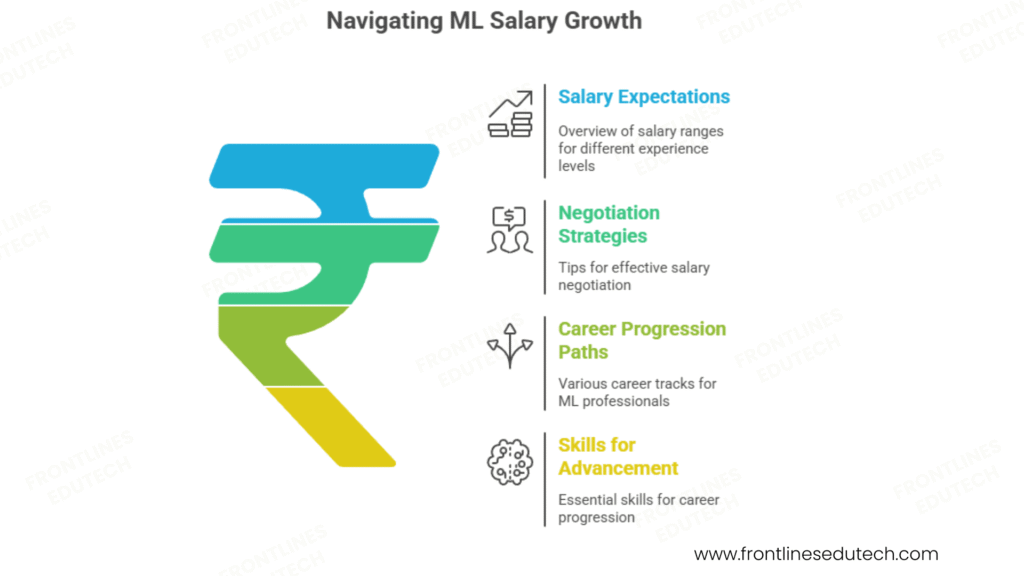
Current Market Rates 2025
Entry-Level ML Engineer Positions (0-2 years):
Location | Salary Range | Average |
Bangalore, Mumbai, Delhi | ₹5-10 LPA | ₹7.5 LPA |
Pune, Hyderabad, Chennai | ₹4-8 LPA | ₹6.2 LPA |
Tier-2 Cities | ₹3.5-7 LPA | ₹5.5 LPA |
Remote Opportunities | ₹5-9 LPA | ₹7 LPA |
Startups (with equity) | ₹4-8 LPA + 0.1-0.5% equity | ₹6.5 LPA |
Mid-Level ML Engineer Positions (2-5 years):
Role | Salary Range | Average |
Senior ML Engineer | ₹10-18 LPA | ₹14 LPA |
ML Team Lead | ₹12-22 LPA | ₹17 LPA |
Applied Scientist | ₹15-25 LPA | ₹19.5 LPA |
Freelance/Contract | ₹2,000-4,500/hour | ₹3,000/hour |
Senior-Level ML Positions (5+ years):
Role | Salary Range | Average |
Principal ML Engineer | ₹22-40 LPA | ₹30 LPA |
ML Engineering Manager | ₹25-45 LPA | ₹34 LPA |
Chief Data Scientist | ₹30-60 LPA | ₹42 LPA |
Independent ML Consultant | ₹3,500-7,000/hour | ₹5,000/hour |
Source: Industry salary reports from Glassdoor, AmbitionBox, and Payscale 2025
Salary Negotiation Strategies
Market Research Preparation:
Research Tools:
- Glassdoor India – Company-specific salary bands with employee reviews
- AmbitionBox – Indian tech company insights and compensation data
- 6figr – Real-time ML engineer salary data from verified professionals
- Levels.fyi – Tech company compensation including equity and bonuses
Factors Influencing ML Salaries:
- Technical Depth – Advanced skills in deep learning, NLP, or computer vision command premium
- Portfolio Quality – Published research, Kaggle medals, open-source contributions
- Domain Expertise – Healthcare, finance, autonomous vehicles pay higher
- Company Type – Product companies typically pay 20-30% more than service companies
- Location – Bangalore ML salaries average 15-20% higher than other cities
Negotiation Best Practices:
- Present Salary Range – Avoid single numbers; use researched market data
- Emphasize Unique Value – Highlight specialized skills (NLP, computer vision) and portfolio achievements
- Consider Total Compensation – Stock options, signing bonus, learning budget, conference attendance
- Professional Response Time – Request 48-72 hours to evaluate comprehensive offer
- Maintain Enthusiasm – Express genuine interest while negotiating respectfully
Sample Negotiation Script:
“Thank you for the offer of ₹8.5 LPA for the ML Engineer position. I’m very excited about this opportunity and the innovative work your team is doing in recommendation systems. Based on my research of market rates for ML engineers with my skill set in deep learning and NLP, plus my portfolio projects including the deployed chatbot system that served 10,000 users, I was expecting compensation in the range of ₹10-11 LPA. Is there flexibility to discuss the salary component?”
Career Progression Paths
Technical Specialist Track:
Junior ML Engineer → Senior ML Engineer → Staff ML Engineer → Principal ML Engineer → Distinguished Engineer/ML Fellow
Focus Areas:
- Deep technical expertise in specific ML domains
- Research and innovation in cutting-edge techniques
- Thought leadership through publications and conferences
- Mentoring junior engineers and code quality leadership
Management Leadership Track:
Senior ML Engineer → Team Lead → ML Engineering Manager → Director of ML → VP of AI/ML
Focus Areas:
- Team building and people management
- Strategic planning and resource allocation
- Cross-functional collaboration with product and business
- Budget management and hiring decisions
Product Specialization Track:
ML Engineer → Senior ML Product Engineer → Staff Product Engineer → ML Product Manager
Focus Areas:
- Product thinking and user-centric ML solutions
- Bridging technical capabilities with business needs
- A/B testing and product experimentation
- Stakeholder management and product roadmaps
Entrepreneurial Path:
Experienced ML Engineer → ML Consultant → Consulting Agency Owner → ML Product Startup Founder
Focus Areas:
- Client relationship management
- Business development and sales
- Building scalable consulting practice
- Product development and fundraising
Skills for Career Advancement
Years 1-2: Foundation Building:
- Master Core ML Algorithms – Become expert in classical and deep learning techniques
- Code Quality Excellence – Write clean, testable, well-documented code
- Domain Knowledge – Understand business context and industry applications
- Communication Skills – Present findings clearly to technical and non-technical audiences
Years 3-5: Specialization and Leadership:
- Deep Specialization – Become expert in NLP, Computer Vision, or Reinforcement Learning
- MLOps Proficiency – Model deployment, monitoring, and production best practices
- Mentoring Capabilities – Guide junior ML engineers and conduct knowledge sharing
- Cloud ML Expertise – AWS SageMaker, Google Vertex AI, or Azure ML certifications
Years 5+: Strategic Impact:
- Architectural Vision – Design scalable ML systems and infrastructure
- Cross-functional Leadership – Collaborate with product, engineering, and business teams
- Innovation Driver – Identify opportunities for ML application in new domains
- Industry Recognition – Publish research, speak at conferences, contribute to ML community
Professional Certifications Worth Pursuing
Cloud ML Certifications
AWS Certified Machine Learning – Specialty
Value: Validates ability to design and implement ML solutions on AWS cloud
Best For: ML engineers working with AWS services or seeking cloud ML roles
Prerequisites: 2+ years of hands-on ML experience on AWS recommended
Cost: $300
Preparation Time: 2-3 months with consistent study
Career Impact: Average 20% salary increase for certified professionals
Google Cloud Professional ML Engineer
Value: Demonstrates proficiency in building ML models on Google Cloud Platform
Best For: Engineers working with GCP or targeting Google ecosystem jobs
Prerequisites: 3+ years industry experience recommended (but not mandatory)
Cost: $200
Preparation Time: 2-3 months
Recognition: Highly valued in companies using GCP infrastructure
Microsoft Azure AI Engineer Associate
Value: Proves expertise in implementing AI solutions using Azure services
Best For: Enterprise-focused ML engineers, especially in Microsoft technology stack companies
Cost: $165
Preparation Time: 6-8 weeks
Market Demand: Growing rapidly as enterprises adopt Azure ML
Specialized ML Certifications
TensorFlow Developer Certificate
Issuer: Google/TensorFlow
Focus: Deep learning model building with TensorFlow
Cost: $100
Duration: 5-hour exam
Value: Demonstrates practical deep learning skills for computer vision and NLP
Deep Learning Specialization (Coursera)
Instructor: Andrew Ng, deeplearning.ai
Coverage: Neural networks, CNNs, RNNs, hyperparameter tuning, sequence models
Cost: $49/month (typically 3-4 months to complete)
Recognition: Industry-recognized foundational deep learning certification
Career Impact of Certifications:
- 60%+ of certified professionals report promotions within 18 months
- 1 in 3 see salary increases exceeding 20% post-certification
- Certifications appear in 40% of ML job postings as preferred qualifications
- Certified candidates receive 35% more interview callbacks
8.Success Stories from Our Students
Vikram Malhotra – From Manual Tester to ML Engineer
Background: 4 years as manual software tester in service company
Challenge: Zero programming experience, wanted to transition into AI/ML field
Journey: Dedicated 3-4 hours daily after work for 10 months, weekends for projects
Timeline: Course completion to first ML job offer in 4 months
Outcome: Machine Learning Engineer at Amazon Development Center, Bangalore
Salary Growth: ₹4.5 LPA → ₹12.8 LPA (184% increase)
Vikram’s Success Strategy:
- Built 12 comprehensive ML projects covering classification, regression, NLP, and computer vision
- Earned 2 Kaggle bronze medals in competition participation
- Created technical blog documenting entire learning journey with 15+ articles
- Attended ML meetups and networked with professionals at PyData Bangalore
Key Advice: “The hardest part was the first month when everything felt overwhelming. I focused on mastering Python thoroughly before touching ML algorithms. Building projects that solved real problems made my portfolio stand out. Interviewers spent more time discussing my Kaggle competition approach than asking theoretical questions.”
Ananya Krishnan – From Civil Engineer to AI Research Scientist
Background: B.Tech in Civil Engineering, 2 years in construction industry
Challenge: Complete career pivot from traditional engineering to cutting-edge AI
Journey: Left job to pursue ML full-time, intensive 8-month focused learning
Timeline: 8 months course + 3 months research projects = First research role in 11 months
Current Position: AI Research Scientist at Microsoft Research India
Salary Progression: ₹3.2 LPA → ₹8.5 LPA (first ML job) → ₹18.5 LPA (current role)
Ananya’s Achievement Highlights:
- Published 2 research papers on computer vision in international conferences
- Developed novel approach to medical image segmentation during capstone
- Contributed to 4 open-source ML projects on GitHub with 500+ combined stars
- Mentored 20+ students transitioning into ML through online communities
Success Principles: “I approached ML like a research problem. Instead of just implementing tutorials, I asked ‘why does this work?’ for every algorithm. This curiosity led me to read research papers early, which differentiated me during interviews. Technical depth combined with genuine passion for the field opened doors to research positions.”
Rahul Shetty – From Freelance Developer to ML Startup CTO
Background: Freelance web developer with 5 years experience in PHP and WordPress
Challenge: Wanted to build intelligent applications and lead technical teams in AI
Journey: Upskilled while continuing freelance work, transitioned gradually over 14 months
Timeline: 10 months learning + 4 months building ML SaaS product = CTO role in startup
Current Role: CTO and Co-founder at HealthTech AI startup (Seed funded)
Equity Value: ₹4.2 crores estimated based on latest funding round valuation
Rahul’s Entrepreneurial Journey:
- Built AI-powered health diagnostic tool as capstone project
- Scaled product to 50,000+ users across 12 Indian cities
- Raised ₹2.5 crores in seed funding from prominent VC firm
- Grew engineering team from solo founder to 18 ML engineers and data scientists
Leadership Insights: “Machine learning skills gave me technical credibility, but understanding healthcare domain, user psychology, and business model design were equally crucial. The combination of ML expertise and entrepreneurial thinking is incredibly powerful in the startup ecosystem. Start by solving one specific problem really well before expanding.”
💰 Ready for High-Paying ML Engineer Roles?
Become job-ready with our Machine Learning Course
9.Common Challenges and Solutions
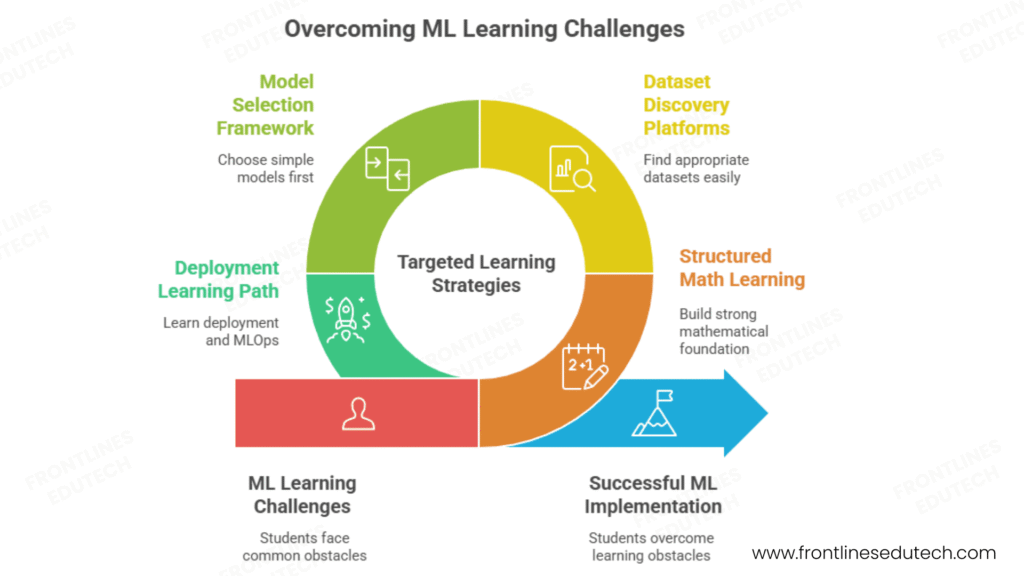
Challenge 1: Mathematical Foundation Gaps
Problem: Many students struggle with the mathematics underlying ML algorithms
Symptoms: Difficulty understanding gradient descent, can’t interpret model parameters, confusion with probability concepts
Solution Strategy:
Structured Math Learning Path:
- Linear Algebra Basics – Start with Khan Academy or 3Blue1Brown’s “Essence of Linear Algebra” YouTube series
- Calculus Foundations – Focus on derivatives and partial derivatives for optimization
- Probability & Statistics – Understand distributions, Bayes’ theorem, and statistical testing
- Practical Application – Implement algorithms from scratch to reinforce math concepts
Resources Recommendation:
- Mathematics for Machine Learning (Imperial College London on Coursera)
- StatQuest YouTube channel for visual explanations
- “The Elements of Statistical Learning” book for reference
- Practice problems on Brilliant.org for interactive learning
Practical Implementation:
- Spend 30 minutes daily on math concepts before coding
- Implement one algorithm from scratch monthly (without libraries)
- Join study groups focused on ML mathematics
- Don’t get stuck perfecting math – learn enough to proceed, deepen over time
Challenge 2: Dataset and Project Idea Paralysis
Problem: Students struggle finding appropriate datasets and real-world project ideas
Symptoms: Repeating same tutorial projects, uncertainty about project complexity, analysis paralysis
Solution Strategy:
Dataset Discovery Platforms:
- Kaggle Datasets – 50,000+ datasets across all domains with community kernels
- UCI Machine Learning Repository – Classic datasets for learning fundamentals
- Google Dataset Search – Search engine specifically for finding datasets
- Data.gov.in – Indian government open data portal
- GitHub Awesome Public Datasets – Curated list of high-quality datasets
Project Progression Framework:
Beginner Level (Months 1-3):
- Iris Flower Classification, Boston Housing Prices, Titanic Survival Prediction
- Focus: Understanding complete ML workflow
Intermediate Level (Months 4-6):
- Customer Segmentation, Movie Recommendation, Sentiment Analysis, Sales Forecasting
- Focus: Feature engineering and model selection
Advanced Level (Months 7-10):
- Real-time Object Detection, Chatbot with NLP, Stock Prediction, Medical Diagnosis System
- Focus: Deep learning and deployment
Business-Oriented Projects:
Choose projects solving actual business problems in domains like healthcare, finance, retail, or education – interviewers value practical problem-solving over technical complexity alone
Challenge 3: Keeping Models Simple vs. Complex
Problem: Tendency to over-engineer solutions or use complex models unnecessarily
Symptoms: Always reaching for neural networks, ignoring simple baselines, poor model interpretability
Solution Strategy:
Model Selection Framework:
- Start Simple – Always begin with logistic regression or decision trees as baseline
- Evaluate Complexity – Only add complexity if simpler models fail to meet requirements
- Consider Interpretability – Business stakeholders often need explainable models
- Measure Real Improvement – Compare models using cross-validation, not just training accuracy
Decision Guide:
- Use Linear/Logistic Regression when relationships are relatively linear and interpretability is crucial
- Use Random Forest/XGBoost for tabular data with complex patterns
- Use Neural Networks only when you have large datasets (10,000+ samples) and complex patterns
- Use Deep Learning for unstructured data (images, text, audio) where it excels
Challenge 4: Production Deployment Knowledge Gap
Problem: Strong modeling skills but lack of deployment and MLOps understanding
Symptoms: Projects exist only as Jupyter notebooks, no API experience, unfamiliarity with cloud platforms
Solution Strategy:
Deployment Learning Path:
- Month 1: Learn Flask/FastAPI – Create REST APIs for your ML models
- Month 2: Docker Fundamentals – Containerize applications for portability
- Month 3: Cloud Basics – Deploy on Heroku (free tier) or AWS Free Tier
- Month 4: Monitoring & Logging – Track model performance in production
Practical Projects:
- Convert existing Jupyter project to Flask API with Docker deployment
- Deploy model on AWS EC2 instance and create simple web interface
- Implement model versioning and A/B testing framework
- Build monitoring dashboard tracking predictions and model drift
Resources:
- “Designing Machine Learning Systems” by Chip Huyen
- Full Stack Deep Learning course (free online)
- AWS SageMaker free tutorials
- MLOps community on Slack and Discord
10. Your Next Steps to Get Started
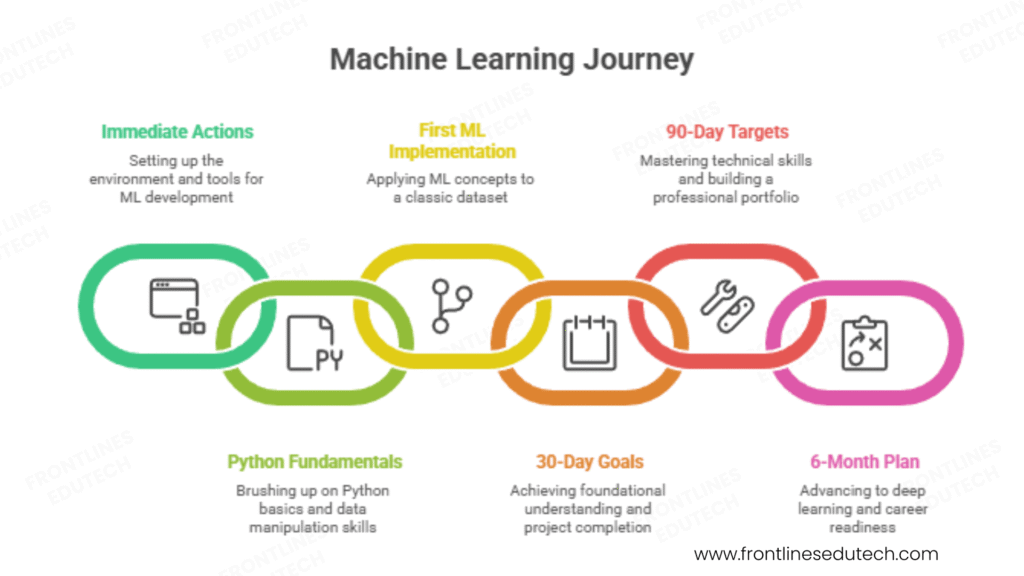
Immediate Actions This Week
Day 1: Development Environment Setup
- Install Python 3.9 or 3.10 – Latest stable version from python.org or Anaconda distribution
- Set up Jupyter Notebook – Interactive environment for ML experimentation
- Create GitHub Account – Version control and professional portfolio showcase
- Install Essential Libraries – NumPy, Pandas, Matplotlib, Scikit-learn using pip or conda
Day 2-3: Python Fundamentals Brush-up
- Complete Python Basics Review – Variables, loops, functions, data structures
- Practice NumPy Operations – Array creation, indexing, mathematical operations
- Pandas DataFrame Manipulation – Loading CSV, filtering, grouping data
- Join ML Learning Communities – r/MachineLearning, r/learnmachinelearning on Reddit
Day 4-5: First ML Implementation
- Download Iris Dataset – Classic beginner dataset from sklearn
- Exploratory Data Analysis – Visualize features and understand patterns
- Train First Model – Simple classification with decision tree or logistic regression
- Evaluate Performance – Calculate accuracy, confusion matrix, understand results
Weekend Project:
Build a simple house price predictor using linear regression with real estate dataset – apply complete ML workflow from data loading to model evaluation
30-Day Milestone Goals
Week 1-2: Python & Math Foundation
- Complete understanding of Python for data manipulation (NumPy, Pandas)
- Build confidence with data visualization (Matplotlib, Seaborn)
- Understand basic statistics – mean, variance, distributions, correlation
- Create 2 data analysis projects with visualization dashboards
Week 3-4: Classical Machine Learning
- Master supervised learning basics – Linear regression, logistic regression
- Understand model evaluation – Train-test split, cross-validation, metrics
- Learn feature engineering – Scaling, encoding, creating new features
- Build 2 complete ML projects (one regression, one classification)
Month-End Self-Assessment:
- Can load, clean, and visualize datasets confidently
- Understand when to use different ML algorithms
- Comfortable with Scikit-learn library for modeling
- Have 4 projects in GitHub repository with documentation
- Ready to progress to advanced algorithms and deep learning
90-Day Achievement Targets
Technical Skills Mastery:
- Backend ML: Proficient in classical algorithms, understanding of neural networks
- Deep Learning: Comfortable with TensorFlow or PyTorch basics, built CNN/RNN models
- NLP or Computer Vision: Chosen specialization with 2-3 domain-specific projects
- Deployment: Deployed at least one model as API or web application
Challenge 1: Transitioning from Basic to Advanced Excel Usage
Problem: Many professionals know basic Excel but struggle with advanced functions and analytical techniques
Impact: Limited career growth, manual processes, difficulty with complex analysis requirements
Symptoms: Over-reliance on basic formulas, manual data manipulation, inability to handle large datasets
Systematic Progression Strategy:
Phase 1: Foundation Strengthening (2-3 weeks)
- Formula Mastery – Master relative vs absolute references, nested functions, error handling
- Data Organization – Learn proper data structure, table formatting, named ranges
- Shortcut Proficiency – Keyboard shortcuts for efficiency, navigation techniques
- Function Categories – Understand lookup, statistical, financial, date/time function groups
Phase 2: Intermediate Skill Building (4-6 weeks)
Portfolio Development:
- 6-8 Complete Projects – Covering different ML domains and complexity levels
- Professional GitHub Profile – Well-documented repositories with README files
- Kaggle Participation – Entered 2-3 competitions, studied winning solutions
- Technical Blog – 3-5 articles explaining ML concepts or project walkthroughs
- LinkedIn Optimization – Professional profile highlighting ML journey and projects
Career Readiness:
- Resume Crafted – ATS-friendly resume with strong project descriptions and metrics
- Interview Preparation – Comfortable with 50+ common ML interview questions
- Networking Initiated – Connected with 50+ ML professionals on LinkedIn
- Job Search Strategy – Identified 20 target companies and researched their ML applications
- Mock Interviews – Completed 3-4 practice interviews with feedback
6-Month Professional Development Plan
Months 1-2: Foundation & Classical ML
- Complete Python, Math, and ML fundamentals
- Master Scikit-learn and classical algorithms
- Build 4-5 beginner to intermediate projects
- Start technical blogging journey
Months 3-4: Deep Learning & Specialization
- Learn TensorFlow or PyTorch thoroughly
- Choose specialization (NLP, Computer Vision, or Time Series)
- Build 3-4 advanced projects in chosen domain
- Participate in Kaggle competitions
Months 5-6: Deployment & Job Preparation
- Learn MLOps, deployment, and cloud ML
- Build 2 end-to-end projects with deployment
- Intensive interview preparation and resume optimization
- Active job applications and networking
Month 6 Career Milestones:
- Professional Portfolio – Comprehensive showcase of ML skills and projects
- Technical Depth – Strong understanding of ML theory and practical application
- Industry Network – Connections with ML professionals and potential referrals
- Job Readiness – Confident in interviews, multiple applications submitted
- Continuous Learning Habit – Established routine for staying updated with ML advancements
Transform Your Career with Frontlines EduTech’s Machine Learning Program
The journey from ML beginner to job-ready engineer is challenging but entirely achievable with structured guidance and dedicated practice. At Frontlines EduTech, we’ve helped hundreds of students successfully transition into Machine Learning roles with our proven, industry-aligned curriculum.
Why Choose Frontlines EduTech for Your ML Journey?
Comprehensive 10-Month Structured Curriculum:
- Month-by-month learning path from Python basics to advanced deep learning
- 30+ hands-on projects covering classification, regression, NLP, computer vision, and deployment
- Specialized tracks in NLP, Computer Vision, or Time Series based on career goals
- Live coding sessions with experienced ML practitioners from top companies
Industry Mentorship & Expert Guidance:
- Learn from ML engineers and data scientists with experience at Google, Amazon, Microsoft, Flipkart
- Weekly doubt-clearing sessions and code review from industry experts
- One-on-one mentorship for career guidance and project feedback
- Guest lectures from ML leaders sharing real-world insights and best practices
Career-Focused Practical Training:
- Build production-ready ML projects, not just academic exercises
- Learn MLOps, deployment, and cloud ML (AWS, GCP) for complete skillset
- Kaggle competition participation with guidance from competition masters
- Capstone project simulating real business problems with end-to-end solution
Job Placement Assistance & Career Support:
- Resume building and optimization for ML roles with ATS compliance
- Interview preparation covering technical, coding, and behavioral questions
- Mock interviews conducted by hiring managers from product companies
- Job referrals to 100+ partner companies actively hiring ML engineers
- LinkedIn profile optimization and personal branding guidance
Lifetime Learning & Community Access:
- Lifetime access to all course materials, recordings, and future curriculum updates
- Exclusive community of 800+ current students and ML professional alumni
- Monthly webinars on latest ML trends, tools, and career opportunities
- Continuous upskilling resources as ML technologies evolve
Our Track Record Speaks for Itself
Student Success Metrics:
- 500+ successful career transitions into ML and AI roles since 2020
- 87% job placement rate within 6 months of course completion
- Average salary increase of 156% for career switchers
- Students placed at Amazon, Microsoft, Flipkart, Paytm, Ola, and 100+ other companies
- 95% student satisfaction rating based on post-graduation surveys
What Sets Us Apart:
Personalized Learning Paths – Not everyone starts from the same point. We assess your background and create customized learning plans matching your goals
Real Business Problem Solving – Work on projects based on actual business cases from e-commerce, healthcare, finance, and education sectors
Flexible Learning Options – Live online classes with weekend batches for working professionals, plus recorded sessions for self-paced learning
Money-Back Job Guarantee – If you don’t secure an ML role within 12 months of course completion (with eligibility criteria met), we refund your entire course fee
Special Benefits for Early Enrollments
Limited-Time Offer for Next Batch:
- 30% early bird discount for registrations within next 7 days
- Free Python & Math preparatory course (₹5,000 value)
- Complimentary AWS Machine Learning certification preparation (₹8,000 value)
- Free access to 50+ hours of recorded masterclasses on advanced ML topics
- Bonus: Interview Preparation Guide with 200+ ML questions and answers
Hear From Our Successful Alumni
“Frontlines EduTech didn’t just teach me machine learning – they transformed my entire career trajectory. The structured curriculum, hands-on projects, and mentorship from industry experts gave me confidence to crack interviews at top companies. Today I’m working as an ML Engineer at Amazon, something I couldn’t have imagined 10 months ago.”
— Vikram Malhotra, ML Engineer at Amazon Development Center
“What impressed me most was the focus on practical, production-ready ML skills. Learning deployment, MLOps, and cloud platforms alongside modeling techniques made me job-ready from day one. The career support team helped me optimize my resume and prepare for interviews systematically. I received 4 job offers within 2 months of completing the course.”
— Ananya Krishnan, AI Research Scientist at Microsoft Research India
Ready to Start Your Machine Learning Journey?
Don’t let another month pass wishing you had ML skills. The AI revolution is happening now, and Machine Learning Engineers are at the forefront of this transformation.
Take the First Step Today:




Contact Information:




Frequently Asked Questions
Q: Do I need a computer science background for this course?
A: No. We’ve successfully trained civil engineers, mechanical engineers, commerce graduates, and professionals from non-technical backgrounds. Our curriculum starts with Python fundamentals and builds up systematically.
Q: How much time should I dedicate daily?
A: We recommend 2-3 hours daily for working professionals. Weekend batches and recorded sessions provide flexibility.
Q: Will I get job placement support?
A: Yes. We provide comprehensive placement assistance including resume building, interview preparation, mock interviews, and referrals to 100+ hiring partner companies.
Q: What’s the average salary for freshers in ML?
A: Fresh ML engineers in India earn ₹5-10 LPA depending on location and company type, with significant growth potential.
Q: Can I balance this course with my current job?
A: Absolutely. 70% of our students are working professionals who learn in evenings and weekends.
Conclusion
Machine Learning Engineering represents one of the most exciting and high-growth career opportunities in technology today. With AI transforming every industry from healthcare to finance to entertainment, ML engineers are at the forefront of innovation shaping our future.
The combination of strong market demand, excellent compensation (₹10.88 LPA average), and meaningful work solving real-world problems makes ML engineering an ideal career choice for both fresh graduates and career switchers.
Success in machine learning requires dedication, structured learning, and consistent practice, but the rewards – both financial and intellectual – are substantial. The 8-10 month roadmap provided in this guide has been tested with hundreds of students at Frontlines EduTech, with 87% achieving their career transition goals.
Key Success Principles to Remember
Consistency Over Intensity – Daily practice for 2-3 hours is more effective than weekend marathons. Build a sustainable learning habit.
Project-Based Learning – Theory provides foundation, but building real applications that solve actual problems creates true expertise and impressive portfolios.
Community Engagement – Learn from and contribute to the ML community through Kaggle, GitHub, meetups, and online forums. Networking accelerates learning and opens opportunities.
Business Understanding – Technical ML skills get you interviews, but understanding business problems and communicating solutions effectively accelerates career growth.
Continuous Learning – ML evolves rapidly. Cultivate habits of reading research papers, following industry leaders, and experimenting with new techniques.
The journey from ML beginner to job-ready engineer is challenging but entirely achievable with the right guidance, structured approach, and unwavering commitment. Every ML expert was once a beginner writing their first Python script and training their first model.
Your machine learning journey starts today. Take the first step.
Whether you choose self-learning or structured guidance through programs like Frontlines EduTech, the important thing is to begin. The AI revolution is happening now, and Machine Learning Engineers are building the future.
Don’t wait for the perfect moment. Start learning Python today, build your first classifier this week, and deploy your first model next month. The career you dream of is built one line of code, one project, and one learning day at a time.
The future belongs to those who build it. Start building yours with machine learning.
About the Author
Priya Venkatesh is a Senior Machine Learning Engineer and Lead Instructor at Frontlines EduTech with over 8 years of experience building AI solutions at companies including Microsoft, Flipkart, and Amazon. She specializes in Natural Language Processing and Computer Vision, with 5 published research papers in international conferences.
Priya has successfully mentored over 500 students in their Machine Learning journey, with an 89% job placement success rate within 6 months of course completion. She holds certifications in AWS Machine Learning Specialty, Google Cloud Professional ML Engineer, and TensorFlow Developer Certificate.
She regularly speaks at ML conferences including PyData Bangalore, presents workshops on applied deep learning, and contributes to open-source ML projects on GitHub. Connect with her on LinkedIn for ML career guidance, industry insights, and learning resources.
Teaching Philosophy: “Machine learning is not just about algorithms and mathematics – it’s about solving real problems that impact people’s lives. The best way to learn ML is by building applications that matter, making mistakes, iterating, and gradually developing both technical depth and problem-solving intuition. Theory is important, but practice creates expertise.”
